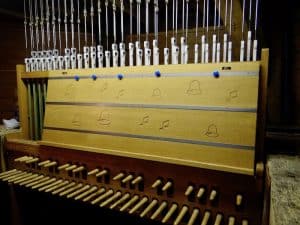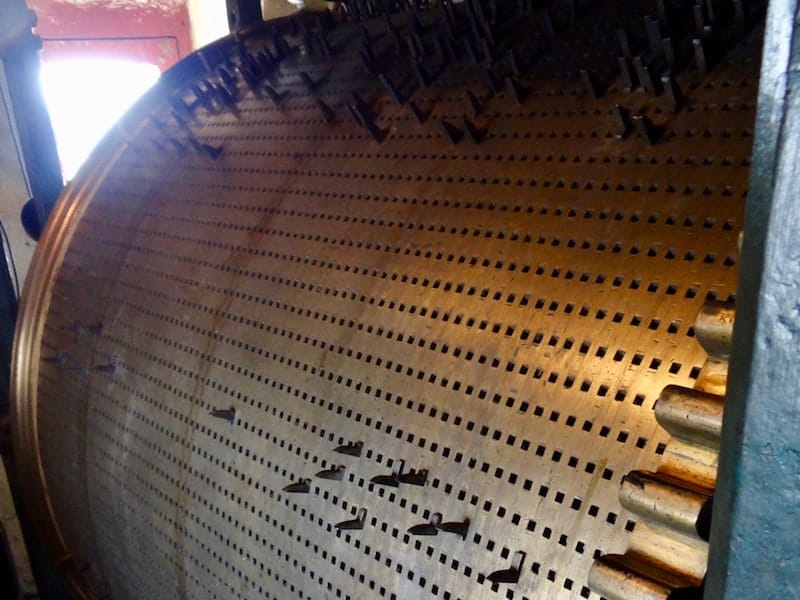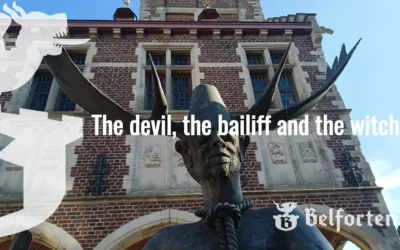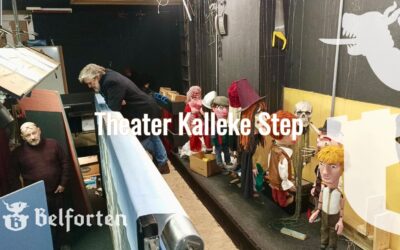Belfort terms
Belfort terms
Arkel Tower
A hanging tower on a corner of two facades.
Bank Clock | Council Fire or Watch Clock
Ringing the bells used to be an important task because bells were the only means of mass communication. Not only were church services announced in a timely manner by sacred bells, the ringing of city bells could announce the closing of city gates, call for council meetings, as well as warn of such things as calamity and fire. Council resolutions and court rulings were noted in the bank bell book and were not legally valid until they were overheard by this bell. So the news reverberated across the region. Hence the expression “putting something on the big clock.” (Source: Wikipedia)
Belfort
Fortified structure not serving a lord but a congregation. A repository of written urban privileges and armory. A watchtower with alarm clock for signaling fires and enemy incursions and a labor clock for organizing daily life and the working day.
Etymology
The word belfort is derived from French beffroi, from Old French berfroi, in turn derived from Old Dutch *bergfriþu “peacekeeper” Bergfried, from Primal Germanic *bergan “to mountain, to preserve” and *friþuz “peace, protection.” Through folk etymological redistribution, beffroi was transformed into belfort in the 13th century, from bel “bell” and fort “fortress, fortification.”
1. Also: belfroot. From the 13th century, a belfry is a bell tower attached to or near a town hall or market hall. These bell towers are especially common in prosperous Flanders. In height, they closely resemble the towers of churches; this is deliberately chosen as a symbol of urban freedom and power. After all, until that time, only the princes and the church had the money to finance this type of building/additions.
In addition, the belfry sometimes has significance as a fortification. (Source: joostdevree.nl)
Carillon
A carillon, carillon or chime is a keyboard-playable musical instrument consisting of one or more sets of bells. A carillon consists of at least 23 cast bronze bells in fixed suspension, tuned in chromatic order (that is, in semitones) that can be made to sound harmonically together(Wikipedia).
The cradle of carillon culture is in the Netherlands and Belgium. Carillonneurs from all over the world come to study in Amersfoort or Mechelen. From the Netherlands and Belgium, carillon culture has spread to other countries as well.
Campanile
A campanile is a bell tower that stands next to a church building but is not an architectural part of it. The word comes from Italian and is derived from campana (bell).(Wikipedia).
Dakruiter
A dormer is a turret on the ridge of a building, often a church. If they are on the crossing or quadrangle of the building, they are called quadrangle tower or quadrangle roof ridge. Roof riders have no foundation of their own: they rest on the roof and are usually made of wood, sometimes of masonry. They are often hexagonal or octagonal(Wikipedia).
Donjon
A keep is the main tower of a castle, usually used as a residential tower.
#1 2003, Flemish Belfries, Michiel Heirman, Davidsfonds Publishers, Leuven.
Fronton
In architecture, the pediment is the crowning of a facade, window or entrance in triangular or segmental form.
Hall Tower
A hall tower is a tower built on top of or next to a cloth hall or other large city hall, usually in cities that had thriving trade during the Middle Ages.
The term “halls” refers to the large covered spaces that served as trading places, often specifically for trading cloth (a type of textile). These halls were centers of economic activity and urban power.
The tower above or adjacent to the hall served multiple functions, including:
- Symbolic function: It was a sign of urban power and autonomy.
- Practical function: The tower often housed bells (to tell time and announce market hours or city activities) and provided views of the city and surrounding area for surveillance purposes.
- Administrative function: In some cases, the tower also served as a repository for important documents or as a place for meetings of city officials.
Although “belfry” and “hall tower” are sometimes used interchangeably, in Flanders the term “hall tower” is often used when the tower is directly attached to a cloth hall or similar hall.
Church Belfry
A church belfry is inseparable from a church but funded by a congregation and functions as a belfry.
Keyboard

In a carillon, the keyboard consists of short and long sticks, also called white and black, although they are not. The layout of these keys is similar to that of a piano, so a pianist will immediately understand what the keys are for, but the method of playing them (with the fists) is different. (source: Wikipedia)
Cloth Hall
A cloth hall (also called a lakenhalle in Flanders) is a building that has its origins in the Middle Ages as a trading and stacking place for cloth. In some places, inspections also took place, and the quality of the cloth was confirmed by the award of a cloth lead(Wikipedia).
Lantern Tower
A synonym of crossing tower. A crossing tower, crossing tower, lantern tower or transept tower is a church tower in the middle of the crossing of a church.(Wikipedia).
Master Mason
If you wanted to be a mason in the 16th or 17th century, you apprenticed for four years to a master mason. You concluded the apprenticeship with a master’s thesis. A master builder was often also called master mason.
Schepenhuis
The Schepenhuis refers to the location where the aldermen’s court held its meetings. In the Middle Ages, this was still generally done outdoors. From the 13th century, stone buildings, usually with a belfry, were erected in which the aldermen could deliberate(Wikipedia).
Play drum
 A playing drum is a part of an automatic carillon. The brass or cast-iron roller in which there is a track of holes for each play hammer into which pins can be inserted. The rotation of the drum triggers a mechanism that automatically drops hammers on bells.
A playing drum is a part of an automatic carillon. The brass or cast-iron roller in which there is a track of holes for each play hammer into which pins can be inserted. The rotation of the drum triggers a mechanism that automatically drops hammers on bells.
City Hall
A city hall (also: raadhuis or gemeentehuis) is a building in which the officials of the municipality, the mayor and aldermen (Netherlands) or aldermen (Belgium) work and where the city council meets(Wikipedia).
City Clock
Clock placed and maintained by the city. (Dikke Van Dale)
buttress
A buttress is a bulge or pillar set against the wallwork to strengthen it.
#1 2003, Flemish Belfries, Michiel Heirman, Davidsfonds Publishers, Leuven.
Bays
A bay (derived from the French word travée, and originally from the Latin trabis, beam) or vault yoke is, among other things, a part of a building defined by two successive supports in the longitudinal direction of the building. A bay is also a concept in the tessellation of a facade. The bay is then the distance at which the facade begins to repeat longitudinally. This corresponds more or less to the widths of doors and windows(Wikipedia).
Celebration Tower
A synonym of lantern tower. A crossing tower, crossing tower, lantern tower or transept tower is a church tower in the middle of the crossing of a church. Celebration towers can be made of stone, but often this is too heavy for the crossing pillars. Therefore, celebration towers are also often made of wood, often protected with a lead covering. Sometimes the celebration tower serves as a bell tower(Wikipedia).
Watchtower
A watchtower or watchtower is a tower used for viewing and monitoring the wide area from a high point(Wikipedia).
West Block
A west block (also called: westwork , west building or west chancel) is a monumental structure on the west side of a church building, often associated with Meusean art, although westworks from the Carolingian, Ottonian or Romanesque period also occur in the German Rhineland and elsewhere(Wikipedia).
The three most recent posts
The judge, the witch and the devil
Three special stories from the history of Tielt are symbolized and immortalized by three statues of Jef Claerhout.
Up in the belfry of Tielt!
Extensive message about the tour of the belfry of Tielt accompanied by a city guide and the subsequent ‘climb’.
Theater Kalleke Step
Notice of an unexpected visit to theater Kalleke Step in Grembergen during a planned visit to Dendermonde.


